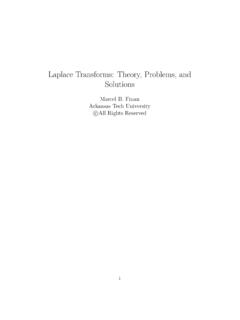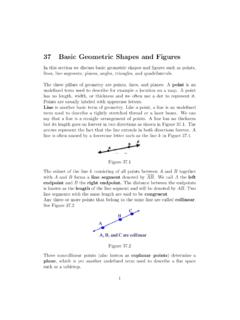Transcription of Environmental Impacts of Nanotechnology and Its Products
1 Environmental Impacts of Nanotechnology and Its Products B. Zhang1, , Dhanasekaran1, D. Kalla2 and R. Asmatulu1 1 Department of Mechanical Engineering Wichita State University 1845 Fairmount, Wichita, KS 67260-0133 2 Department of Engineering Technology Metropolitan State College of Denver Denver, CO, 80014, USA Abstract Nanotechnology increases the strengths of many materials and devices, as well as enhances efficiencies of monitoring devices, remediation of Environmental pollution, and renewable energy production. While these are considered to be the positive effect of Nanotechnology , there are certain negative Impacts of Nanotechnology on environment in many ways, such as increased toxicological pollution on the environment due to the uncertain shape, size, and chemical compositions of some of the Nanotechnology Products (or nanomaterials).
2 It can be vital to understand the risks of using nanomaterials, and cost of the resulting damage. It is required to conduct a risk assessment and full life-cycle analysis for Nanotechnology Products at all stages of Products to understand the hazards of nanoproducts and the resultant knowledge that can then be used to predict the possible positive and negative Impacts of the nanoscale Products . Choosing right, less toxic materials ( , graphene) will make huge Impacts on the environment. This can be very useful for the training and protection of students, as well as scientists, engineers, policymakers, and regulators working in the field.
3 Keyword: Nanotechnology , Environmental Impacts and recent developments. Email: 1. Introduction Nanotechnology utilizes the unique properties of nanomaterials which has at least one dimensional size of a material between 1 nm to 100 nm to produce nanoscale devices, components, and systems1. Applications utilizing Nanotechnology includes manufacturing various Products , measuring, imaging and manipulating matter on the nanoscale. Nanotechnology is of considerable interest by scientists in the fields of nanocomposites, biocomposites, optical, biomedical, and electronic manufacturing2-4. Nanoparticles are currently being developed fervently, and one novel application includes polymer based composite materials used in the aircraft and wind industries5,6.
4 Nanoscale materials can be different in properties compared to bulk materials for two reasons: Nanoscaled particles have relatively larger surface area per unit mass which is the critical factor to increase mechanical modulus and other physical and chemical properties. 2 Proceedings of the 2011 Midwest Section Conference of the American Society for Engineering Education Basic material properties are changed at nanoscale due to the dominance of quantum effects and lesser imperfections7. In general, Nanotechnology devices consume less energy, reduce material wastes, and help in monitoring. Nanotechnology can also be used to reduce and prevent the toxicity of nanoparticles in environment more efficiently8.
5 There are certain areas of manufacturing currently benefiting from the development of Nanotechnology : Energy consumption: The use of graphene into a coating material resulting in the need for only one layer, which does not require a multifunctional film coating. Two applications for a graphene based coating are to apply it to a blade used in wind turbines or on the body of an airplane. It saves the weight increasing efficiency. Cost saving on materials: An alternative energy method such as hybrid automobiles will decrease the price by novel developments in Nanotechnology . Less waste on raw materials: Large sample testing will be done on a smaller scale and simultaneously use of raw materials will become more efficiency.
6 Nanoscale chemical reagents (or catalysts) increase the reaction rate and other efficiency of chemical reactions. Environmental monitoring and protection: Utilizing advanced Nanotechnology , a detector was made to detect a nuclear leak faster and more accurate at the Fukushima Daiichi Nuclear Power Plant. Which is one of the best radiation detector in Washington and can sense the faintest amount of radiation9 . Biological applications: Developing ultra-small probes on planetary surfaces for agricultural applications and control of soil, air, and water contamination . Biomedical applications: This includes the medical diagnostic and treatments.
7 Polymer composite materials when compared to traditional structural materials made out of metals have a reduced weight, high specific modulus and high resistance to Environmental effects; however, polymer composites with nanoparticle reinforcement to composite materials offer engineers and scientists more options to tailor the material properties to meet design specifications. Common nanoparticles include nanofibers, buckyballs, carbon nanotubes, and graphene, etc. Nanodevices can also be made by using nanotechnology10 and are used in many applications, such as sun glasses, sun screen, semiconductor, and sports equipment, etc.
8 Nanotechnology can provide future solutions for certain Environmental problems; however, it also creates negative Impacts on the environment. Therefore, evaluation of the positive and negative Impacts of Nanotechnology is essential for the safety of society. 2. Potential Environmental Effects Nanoparticles have higher surface areas than the bulk materials which can cause more damage to the human body and environment compared to the bulk particles. Therefore, concern for the potential risk to the society due to nanoparticles has attracted national and international attentions. Nanoparticles are not only beneficial to tailor the properties of polymeric composite materials and environment in air pollution monitoring, but also to help reduce material consumption and remediation (Figure 1).
9 For example, carbon nanotube and graphene based coatings have been 3 Proceedings of the 2011 Midwest Section Conference of the American Society for Engineering Education developed to reduce the weathering effects on composites used for wind turbines and aircraft. Graphene has been chosen to be a better nanoscale inclusion to reduce the degradation of UV exposure and salt. By using Nanotechnology to apply a nanoscale coating on existing materials, the material will last longer and retain the initial strength longer in the presence of salt and UV exposure. Carbon nanotubes have been used to increase the performance of data information system.
10 However, there are few considerations of potential risks need to be considered using nanoparticles: The major problem of nanomaterials is the nanoparticle analysis method. As Nanotechnology improves, new and novel nanomaterials are gradually developed. However, the materials vary by shape and size which are important factors in determining the toxicity. Lack of information and methods of characterizing nanomaterials make existing technology extremely difficult to detect the nanoparticles in air for Environmental protection. Also, information of the chemical structure is a critical factor to determine how toxic a nanomaterial is, and minor changes of chemical function group could drastically change its properties.









